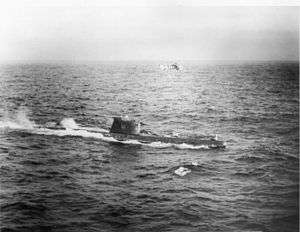Soviet submarine B-59
 B-59 near Cuba with a US Navy helicopter circling above, circa October 28–29, 1962 | |
| History | |
|---|---|
| Name: | B-59 |
| Builder: | Admiralty Shipyard |
| Laid down: | 21 February 1960[1] |
| Launched: | 11 June 1960 |
| Commissioned: | 6 October 1961 |
| Decommissioned: | 19 April 1990[1] |
| General characteristics | |
| Class and type: | Foxtrot-class submarine |
| Displacement: |
|
| Length: | 91.3 m (299 ft 6 in) |
| Beam: | 7.5 m (24 ft 7 in) |
| Propulsion: |
|
| Speed: | |
| Range: |
|
| Complement: | 70 |
| Armament: |
|
Soviet submarine B-59 (Russian: Б-59) was a Project 641 or Foxtrot-class diesel-electric submarine of the Soviet Navy. It played a key role in the Cuban Missile Crisis, when senior officers—believing they were under attack—considered launching a T-5 nuclear torpedo.
Background
On October 1, 1962, the Project 641 [Foxtrot] diesel-electric submarine B-59, as the flagship of a detachment with its sister ships B-36, B-4 and B-130, sailed from its base on the Kola Peninsula to the Caribbean Sea, in support of Soviet arms deliveries to Cuba (an operation known to the Soviets as Anadyr).
However, on October 27, units of the United States Navy – the aircraft carrier USS Randolph and 11 destroyers – detected B-59 near Cuba. US vessels began dropping depth charges of the type used for naval training and containing very little charge. The purpose was to attempt to force the submarine to the surface for positive identification. Messages from the US Navy, to communicate that practice depth charges were being used, never reached B-59 or, it seems, Soviet naval HQ.
Nuclear launch
B-59 had not been in contact with Moscow for a number of days and, although the submarine's crew had earlier been picking up US civilian radio broadcasts, once they began attempting to hide from its pursuers, it was too deep to monitor any radio traffic, so those on board did not know whether or not war had broken out. The captain of the submarine, Valentin Grigorievitch Savitsky, believing that war had already started, wanted to launch the nuclear torpedo.
The three primary officers on board – Captain Valentin Savitsky, the political officer Ivan Semonovich Maslennikov, and commander of the deployed submarine detachment Vasili Arkhipov, equal in rank to Savitsky but the senior officer aboard B-59, were only authorized to launch the torpedo if they all unanimously agreed to do so. B-59 was the only sub in the flotilla that required three officers' authorization in order to fire the "Special Weapon". The other three subs only required the captain and the political officer to approve the launch, but, due to Arkhipov's position as detachment commander, B-59's captain and political officer were required to gain his approval as well. Arkhipov alone opposed the launch, and eventually he persuaded Savitsky to surface the submarine and await orders from Moscow.
As the submarine's batteries had run very low and its air-conditioning had failed, B-59 had to surface in order to use its diesel engine, and it surfaced amid the US warships pursuing it. B-59 then set course for the USSR.
Notes
References
- "Projet 641 Liste des unités" (in French). 2014-10-27. Archived from the original on 2014-10-27.
- Polmar, Norman, Cold War Submarines, The Design and Construction of U.S. and Soviet Submarines. KJ More. Potomac Books, Inc., 2003. ISBN 1-57488-530-8
- Peter A. Huchthausen (2002). October Fury. John Wiley & Sons. ISBN 978-0-471-43357-6.
- "Cuban Missile Crisis: The Man Who Saved the World", Secrets of the Dead, PBS TV documentary, October 24, 2012
- William Burr and Thomas S. Blanton, editors (October 31, 2002) "The Submarines of October. U.S. and Soviet Naval Encounters During the Cuban Missile Crisis", National Security Archive Electronic Briefing Book No. 75
- Savranskaya, Svetlana V. "New Sources on the Role of Soviet Submarines in the Cuban Missile Crisis". Journal of Strategic Studies 28.2 (2005): 233-259. doi:10.1080/01402390500088312
- Ketov, Ryurik A. "The Cuban Missile Crisis as seen through a periscope." Journal of Strategic Studies 28.2 (2005): 217-231. doi:10.1080/01402390500088304